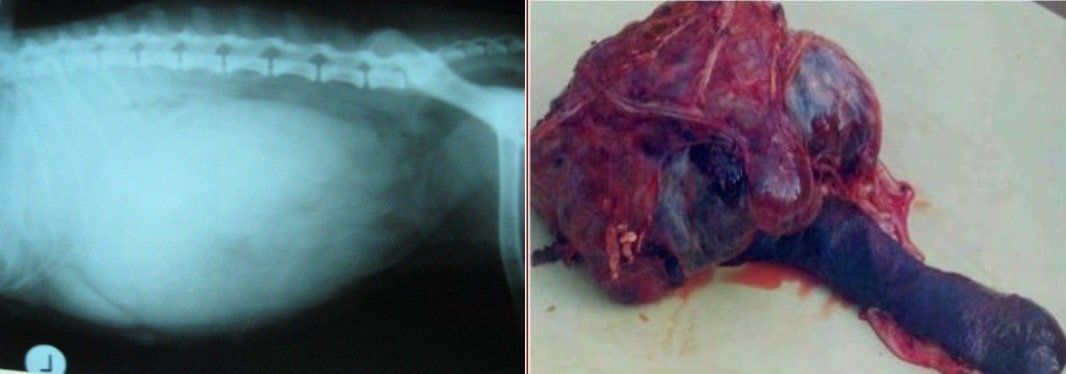TABLE OF CONTENTS
Surgical affections of Spleen
Surgical affections of Spleen in animals are Splenomegaly, Torsion of the spleen, Tumors of Spleen, Splenic infarction etc.
Surgical affections of Spleen in animals are-
Surgical corrections of Spleen in animals are-
Splenomegaly
Splenomegaly is an enlargement of the spleen. It may be symmetrical or asymmetrical-
Symmetrical Splenomegaly
Symmetrical Splenomegaly seen in-
- Congenital (vascular disorders)
- Hepatic cirrhosis
- Splenic torsionBlood parasites
- Hemolytic anemia
Asymmetrical Splenomegaly
Asymmetrical Splenomegaly seen in-
- Tumors of vascular cells and CT
- Hemorrhagic sarcoma-primary tumors of spleen
- Fibrosarcomas and leiomyosarcoma
Torsion of the spleen
Twists or rotates on its vascular pedicle, occluding vessels to splenic hilus sometimes due to GDV.
- Less severe form of splenic– with mild Gastro intestinal disturbance
- Severe form of splenic torsion– Cardio vascular collapse & shock
Symptoms
- Salivation
- Retching
- Increased Respiration rate
- Tucked up abdomen
- Low Haemoglobin and PCV
- Leucocytosis
Treatment
Partial or total splenectomy can be done if torsion is prolonged and it caused necrosis of spleen.
Tumors of Spleen
Spleen cancers are typically secondary. The most common causes of spleen cancer are lymphomas and leukemias.

Treatment
Surgical excision of tumors or Splenectomy of spleen if tumor is spread all over spleen.
Splenic infarction
Splenic infarction occurs when the blood supply to the spleen is compromised resulting in tissue ischemia and eventual necrosis of the spleen.
Treatment
Partial or total Splenectomy of the necrosed part of the spleen.
Splenectomy
Splenectomy is surgical removal of spleen. It may be partial or total.
- Partial Splenectomy: Removal of a part of spleen
- Total Splenectomy: Removal of whole spleen
Indications
- Traumatic lesions
- Splenic infarcts
- Focal lesions
- Total Splenectomy
- Splenic neoplasia
- Splenic torsion
- Severe trauma
- Unsuccessful therapy for immune mediated haematological disorder
Elective Splenectomy is often performed in dogs used as donors to reduce the risk to transfer blood protozoa to uninfected animal during transfusion.
Contraindication
Splenectomy is contraindicated in patients with bone marrow hypoplasia where spleen is main site of hematopoiesis.
Consideration for Splenectomy
- Middle-aged or older patients
- Proper nutritional & metabolic status of patients
- Concurrent haematological disorders
Surgical anatomy of spleen
Spleen is located in the left cranial abdominal quadrant. It usually lies parallel to the greater curvature of stomach but exact location depends on its size and position of other abdominal organs.
In contracted stomach it lies in rib cage while in gastric enlargement it lies in caudal abdomen.
Spleen is covered by a capsule. It is attached to the stomach by gastrosplenic ligament.
Blood supply of spleen
Blood supply of spleen is from splenic artery, a branch of celiac artery. Splenic artery gives off 3-5 primary branches in greater omentum towards ventral spleen.
Venous drainage is via splenic vein into gastro splenic vein that empties into portal vein.
Pre operative management
- Fluid and electrolyte deficits should be corrected. Whole blood transfusion in severe blood loss is needed.
- Peri-operative antibiotic therapy can be given
- Cardiac status to be monitored
Techniques used in splenectomy
Partial splenectomy technique
- In dorsal recumbency laparotomy is performed and spleen is exposed
- Desired area to be defined and double ligate and incise the hilar vessels supplying the area
- Squeeze splenic tissue between thumb and forefinger at the line of lesion and milk splenic pulp towards lesion
- Place forceps on either side of the line dividing healthy spleen and lesion and resect off the spleen between the forceps
- Close cut surface in continuous pattern by absorbable suture. Double row can be applied
- One or 2 rows of continuous overlapping mattress sutures can be applied. Haemorrhage can be controlled by surgical diathermy
- Abdomen & skin can be closed in routine manner
Total splenectomy technique
- In dorsal recumbency laparotomy is performed and spleen is exposed. Place moistened abdominal sponges under spleen
- Squeeze splenic tissue between thumb and forefinger Double ligate and transect all the vessels at splenic hilus with absorbable or non-absorbable suture
- Transect the attachment to stomach and remove spleen. Abdomen and skin can be closed as usual
Post operative care
- Antibiotic and anti-inflammatory drug to be given parenterally
- 24 hr monitoring for haemorrhage
- Fluid therapy to stabilize hypotension
- Daily dressing of surgical site
- Long term antibiotic to counteract the immunosuppression
- Skin suture can be removed after 10-14 days
Complications of splenectomy
Complications of splenectomy are-
- Haemorrhage
- Immunosuppression